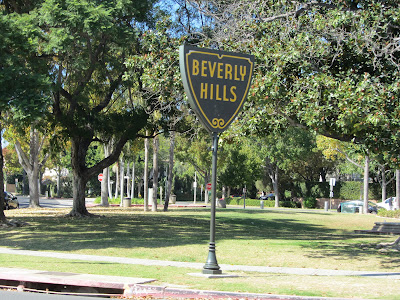After reaching the end of Route 66 yesterday, we bolted back east. Greater L.A. sprawls about 80 miles north, south and east of downtown.
It took about 3 hours in rush-hour traffic to escape the suburban sprawl of southern California, up and over the mountains to the Mojave desert.
We spent the night in Yucca, close to the north entrance of Joshua Tree National Park. We visited the park in the morning.
Whereas the Sonoran desert is lower, warmer, wetter, and has its iconic saguaro cactus, the Mojave is higher, cooler, drier and has lots of yucca plants. The most famous yucca is the Joshua Tree, found where the Mojave and the Sonoran meet.
 |
| A field of Joshua Trees in the distance. |
 |
| The Joshua tree reaches about 20 feet in height. |
 |
The park is also home to many rounded rock formations. These are a type of granite that fractures into blocks, and then weathers into rounded corners by groundwater. When the overlying rock is eroded, the rounded rocks are exposed.
|
 |
| The vertical cracks in these rocks make them very popular with rock climbers. |
 |
The San Andreas fault is visible as it runs through the valley here.
|
 |
Bee careful. We are close enough to Mexico that so-called "killer bees" are a problem.
|
 |
| The view from Keys Point: Palm Desert is barely visible at the base of
the mountain in the distance. |
 |
| The Salton Sea is barely visible in the distance. It is not mist; it is smog. The winds
coming in off the Pacific ocean exit through these valleys, carrying the
pollution of the millions living in southern California with them. The air quality today was "moderate". |
 |
| Cap Rock looks like it is about to fall down. Geologically speaking, that is true. |
 |
| Look closely, and you will see a couple of rock climbers sunning themselves on the top of Hidden Horrors. |
 |
| The aptly-named Skull Rock. |
 |
| A large cluster of cholla cacti. These are 2 to 3 feet tall. |
|
|
The drive through the park was about 60 miles. After exiting the park on the south side, we drove through the vast agricultural belt that extends south and east of here, where citrus, dates and grapes are grown using irrigation water from the [once-mighty] Colorado river. We didn't stop to take a lot of photos, and headed for Yuma to stay the night.
 |
| Elfrida slowed way down to check this place out. I am wondering if they are a subsidiary of Pfizer Corp. |





























































